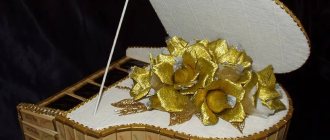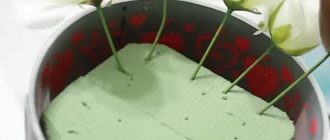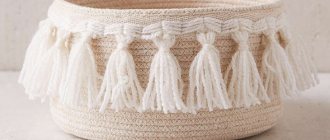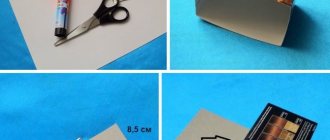Category: Ideas for the home Published 06/30/2019 · Comments: · Reading time: 6 min · Views: 758
Hello, friends, readers and guests of the Domovenok-Art blog! Those who have been with us for a long time are probably accustomed to the fact that handicrafts here, as a rule, are homemade (that’s how it was originally intended). But today’s master class is clearly out of line with the general concept of the blog. Let's go outside! Because today we will weave... Yes! DIY decorative wattle fence made from grapevine.
Basket made of wicker: a lesson for beginners
Each basket has its own specific weaving patterns. Those who want to learn from professionals can go to specialized courses, where they will learn not only the basics of this business, but also learn all the nuances and subtleties of creating wickerwork.
Step-by-step instructions for weaving:
- Prepare the required number of willow twigs. They should be laid out on a flat surface. If you prepare the material yourself, do not forget to dry it first.
- The basket must be made from soaked rods. Soaking will help make the vine more flexible and prevent it from breaking while working. To do this, you need to immerse them in water for at least two days.
- Cut the twigs down to the base. It is necessary to cut according to the size of the future product. For a small basket you will need a vine 30 centimeters long. For a larger product, take rods twice as long.
- 4 rods will serve as the base. Make a slit about 5 centimeters long in the middle.
- You can assemble the base. Place the prepared 4 rods crosswise. Twigs without slots should lie perpendicular.
- Now you can start weaving. You need to insert two rods into the workpiece and braid them around the others. This gives the shape of the future basket.
- To strengthen the base, make sure that the weaving is in pairs. The vine should lie tightly in one direction without twisting.
- As soon as you manage to weave two rows, separate the rays of the base.
- Add all working twigs as needed.
- To create walls, you need to install side racks.
- After you have finished making the walls, start making the handles. To do this you will need 5 thin rods.
Wicker furniture
Wicker furniture is an interior decoration. It is appropriate both in the country house or in the winter garden, and in a chic living room. It is suitable for home and restaurant. Furniture woven from wicker was used both in palace interiors, surprising with its exquisite decoration of silver and gold, and in simple houses. Classic English and French interiors are unthinkable without it. But the willow vine allows you to create a wide variety of forms that will fit into the most radical interior without violating the concept. Wicker furniture includes cozy armchairs, majestic sofas, laconic stools, tea tables, bookcases, and even beds and playpens. Wickerwork is used as finishing for cabinets, cabinets, and chests of drawers.
Wicker armchairs, a table and a floor lamp - interior decoration A rocking chair made of wicker and an openwork table - coziness in the interior Wicker whatnot - lightness in a classic interior A wicker table will decorate any interior Wicker furniture in a calm classic style Lace weaving from wicker for the comfort and lightness of the interior
Wicker furniture goes perfectly with wood and stone, with animal skins. It makes any room warmer and closer to people. It is not without reason that it is traditionally used in rooms intended for recreation. Such furniture is very functional, it is very light, and you can rearrange it at any time. She is never cold. It is convenient for people of all ages - it’s a grandmother’s rocking chair, a cradle for a baby, and some strange object in a teenager’s room.
Wicker furniture is in harmony with wood, stone and animal skins Wicker furniture - a cozy corner for drinking tea Wicker furniture - decoration of a garden, veranda, room Wicker furniture in the interior of a winter garden Wicker chair - a feeling of warmth in the interior Wicker cradle for a nursery A laconic set of wicker furniture for the interior Wicker bed for a classic bedroom Original wicker chairs - the highlight of the design Bedside tables decorated with wicker Living room with wicker furniture Original wicker chair for a modern interior Comfortable wicker chairs for a Japanese-style interior Wicker furniture for an office Wicker furniture and accessories in the interior of a teenager's room Wicker furniture for the interior of a dining room Wicker bedroom furniture Wicker chests of drawers in the bathroom interior Cozy wicker furniture Wicker stool in the interior - beautiful and practical
Wicker houses for animals in the interior look very stylish, make the room cozy, and are usually very popular with pets.
Wicker house for a cat - interior decoration Wicker bird feeder Wicker house for animals
Small secrets of weaving from willow twigs
There are little tricks that will help make wicker weaving easier and more enjoyable.
Features of work
- All rods must be soaked for several days. This will allow them to become softer and more flexible. If the vine is very tough, you can boil it a little.
- If you lose flexibility during the work process, you must use a sprayer.
- For weaving, you should take rods of different thicknesses. A thicker vine will be suitable for the base.
- Don't forget to dry the soaked vine.
- To make the basket beautiful, you need to press the rods tightly against each other and make sure that they are not twisted.
Tools for work
To make a wicker basket at home, you will need tools such as an awl, pruning shears, wire cutters, a knife and templates. All this should be prepared in advance, before work, and placed next to the workplace.
Harvesting vines
All rods must be cut diagonally using hand pruners. Such an oblique cut should not have flakes. Keep it clean. Sort according to length and width.
It is best to store green vines in the fresh air, this will allow them to dry out a little. It is prohibited to store the preparations in damp conditions, otherwise mold may soon appear on the vine.
Preparing the vine should include cleaning the workpieces from dirt and bark. When properly processed, the rods are white and shiny. After this, you can dry them for further work.
Weaving material
— Where do you get the material for your products?
Probably, few people, except for the masters of wicker weaving, pay attention to the bushes growing along roads, along the banks of rivers, in overgrown meadows, and forest edges. Most of them are different types of willow. People often call them brooms, and weavers call them vines. In the first year of life, the willow grows a thin twig - an annual shoot. It is these shoots that are used for weaving.
I have repeatedly been convinced that if you cut off an old willow bush, many annual shoots will come from the stumps. Therefore, the main places for harvesting rods are, of course, cuttings along roads, power lines, clearings, as well as river banks, fieldsides after arson and clearing.
Of all the wild willows, for example, I give preference to almond-leaved willow, or, in common parlance, belotal. Firstly, it has shiny khaki-colored shoots of different shades, and there are lighter places on the bark.
In order to determine the suitability of the vine for weaving, I bend the rod around my hand several times. Naturally, the most flexible, elastic, durable and long rods will be the best for weaving.
Grapevine furniture
Wicker furniture looks expensive and presentable in any interior. If you wish, you can make your own chair from grape vines. To do this, prepare all the necessary materials and templates in advance:
- Choose only high-quality material for blanks.
- Treat the rods. Be sure to remove the bark from them. Dry and put in water for several days. This will allow the vine to become more flexible in its work.
- You can start assembling the structure. If necessary, you need to trim the vine to the required parameters. The first thing we need to do is the frame of our product.
- Let's start attaching the legs to the frame. To make the structure more reliable, you can use an additional fastener - a rope.
- We weave according to the scheme: a horizontal vine is placed on a vertical one. Next, braids are knitted and knots are woven.
- The final stage is varnishing or painting the product.
If you really want, you can learn such an interesting and exciting activity as weaving with wicker. The technology itself does not require any special skills. Beginners can make simple things, such as small baskets.
For craftsmen with little experience, it is recommended to attend specialized courses, where they can learn various nuances and discover all the tricks in working with grapevines.
Weaving from willow twigs develops such wonderful qualities in a person as attentiveness and perseverance. Helps develop fine motor skills and beautiful taste. After all, wicker furniture fits beautifully into any interior, adding elegance to it.
Part 2. Practical. We make a wattle fence with our own hands from a grapevine.
Did you like the fairy tale? Now to the point! If you have any other thin long branches - ok. With them the fence will turn out even more even. However, I cannot give you practical recommendations for preparing other materials. But as for the grapevine, I can say that it is best to use a recently cut vine, since it is more flexible and easier to lay down without creases. But, if it so happens that you missed this moment, it’s okay, a fence can be woven from a vine that has lain for a couple of months and has dried out quite well.
How do I know? Because this is exactly my story.
So, I offer the master class in 2 formats: a full video and the resulting text. Watch the video right now. Read the text below)))
To make a grapevine wicker, we need only three types of materials :
- the vine is straighter and longer;
- thicker sticks (for example, cherry, acacia);
- wire.
And women's instruments))))):
- hacksaw;
- hammer;
- sharp knife;
- pruner;
- pliers.
How to make a wicker fence from a grapevine with your own hands
Cut the thick sticks into equal parts. To do this, you need to know the future height of the fence, plus a margin of about 20 cm for driving into the ground.
Vine in the country - design and decoration
Every year, design and site design trends are becoming more widespread. What you don’t see today from our gardeners and gardeners! And, to paraphrase one famous expression, we can say: dachas have become better, dachas have become more beautiful.
So the author of this article makes wonderful frames for beds from vines on his site. Aesthetically pleasing, very unusual, simple and, it should be noted, beautiful and original. After all, at a dacha, first of all, you need to take care of the improvement of your site, the author believes. - So that it not only provides food, but also pleases with beauty.
About 15 years ago I became interested in wicker weaving. Having accidentally seen a publication about the technique of weaving from wicker in one of the bookstores, I was inspired to try to weave something. And, I must say, everything worked out for him right away.










